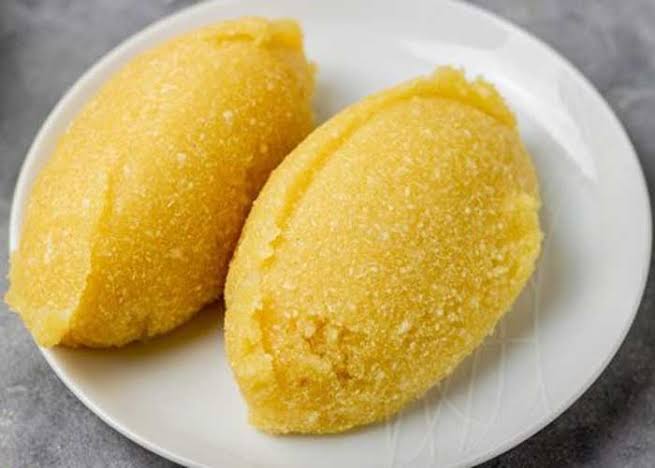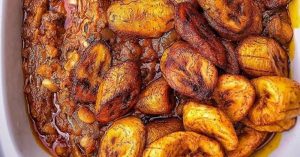
The art of making the perfect Nigerian eba is something that many households across Nigeria take pride in. This simple yet versatile staple is an integral part of many Nigerian meals, providing the foundation for various soups and stews. But while eba might seem straightforward, there are subtle techniques that ensure it comes out just right, soft, lump-free, and perfectly moldable.
What is Nigerian Eba?
Eba is a starchy food made from garri, a granulated product derived from cassava. It is prepared by stirring garri into boiling water until it forms a smooth, dough-like consistency. Known for its firm texture and slight tang, eba is a favorite across Nigeria because it pairs well with rich soups like egusi, okra, and ogbono.
Ingredients for Making Perfect Eba
- Garri (white or yellow, depending on your preference)
- Boiling water
- A wooden spoon or spatula for stirring
The ingredients may be simple, but achieving the perfect texture requires careful attention to the process. It’s not just about dumping garri into water; it’s about striking the right balance between garri and water, and stirring at just the right moment.
Step-by-Step Guide to Preparing Eba
Mastering the art of making eba involves getting a few key techniques right. Here’s a breakdown:
1. Start with the Right Ratio
The perfect ratio of garri to water is essential for achieving the right consistency. Too little water can make the eba too hard, while too much will result in a mushy mess. A good rule of thumb is to use 1 cup of garri for every 2 cups of water.
2. Boil the Water
Bring the water to a rolling boil. You’ll know it’s ready when bubbles start to break on the surface. Boiling the water thoroughly is important because lukewarm water will not activate the garri properly, leaving you with a lumpy and undercooked result.
3. Pour and Stir Immediately
As soon as the water reaches a boil, reduce the heat slightly and start to pour in the garri. Stir quickly and continuously using a wooden spoon or spatula. This helps to evenly distribute the heat and prevents the formation of lumps.
4. Adjust the Texture
If the eba seems too hard, you can soften it by adding small amounts of hot water and stirring again until it reaches your desired texture. If it feels too soft, sprinkle a little more garri and stir until the consistency improves.
5. Shape and Serve
Once the eba is smooth and lump-free, use the spoon to mold it into a round shape or any other desired form. Serve it hot with your favorite Nigerian soup. Popular pairings include egusi, efo riro, and vegetable soup.
Common Mistakes When Making Eba
Even though eba is a relatively simple dish, there are common mistakes people make, especially when they are unfamiliar with the process:
- Using cold or lukewarm water, which leads to an undercooked texture.
- Adding too much garri at once, which results in clumps that are hard to break apart.
- Not stirring quickly enough, causing the eba to set unevenly.
- Leaving it too long before serving, making it dry out and lose its soft, moldable quality.
Why Texture is Key
The texture of eba is critical. It should be soft enough to mold, yet firm enough to pick up soup without crumbling. A perfectly made eba enhances the eating experience by complementing the rich flavors of the accompanying soup without overwhelming it.
Texture is also a matter of personal preference, some people prefer a firmer eba, while others like it softer. Understanding the techniques for adjusting texture helps you tailor it to your taste.
The Cultural Significance of Eba
Eba is more than just a meal; it is a cultural symbol in Nigeria. Many families pass down their unique methods of making it, with subtle regional differences in preparation and texture. It is often seen as a comfort food, especially when paired with traditional soups that hold deep cultural and familial significance.
Moreover, eba has become a representation of Nigerian resilience. It is affordable, easy to prepare, and can be made with minimal ingredients, making it a vital part of daily life for many households across the country.
Final Thoughts: The Art of Perfecting Eba
Making the meal takes practice, but it’s a skill that every Nigerian home cook can master with time and patience. By focusing on the key techniques, using the right ratio of garri to water, stirring quickly, and adjusting the texture, you’ll be able to create a satisfying, lump-free dish every time. And as a staple in Nigerian cuisine, learning to make eba well is a rewarding way to connect with the rich culinary traditions of the country.
Discover more from Amebo Media
Subscribe now to keep reading and get access to the full archive.




